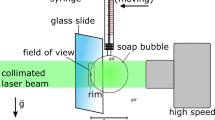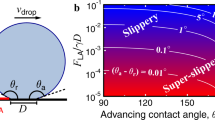Abstract
PERHAPS my letter of Jan. 29 requires some further explanation. I did not suppose that the particles were redeposited as a dust on the surface, expecting them to coalesce spontaneously to a polished layer; this would of course be impossible. If, however, we examine what would happen to the molecules on the liquefaction hypothesis and on mine, it appears that mine is simpler and more probable. On the liquefaction hypothesis, the forces of adhesion between the moving polisher and the surface (constituting friction) are supposed to produce heat first; this heat then liquefies the surface layer. That means that the friction sets up irregular thermal vibrations in the surface molecules; it is then necessary to suppose that the energy of these vibrations is dissipated less rapidly than it accumulates, owing to the small thermal conductivity of the material; finally, the vibrations become so intense that the molecules can no longer stay in their positions in the solid, and ‘melting’ occurs. It must further be supposed that the surface lavers remain liquid sufficiently long to flow to a plane surface, with whatever assistance may be given by the motion of the polisher.
This is a preview of subscription content, access via your institution
Access options
Subscribe to this journal
Receive 51 print issues and online access
$199.00 per year
only $3.90 per issue
Buy this article
- Purchase on Springer Link
- Instant access to full article PDF
Prices may be subject to local taxes which are calculated during checkout
Similar content being viewed by others
Author information
Authors and Affiliations
Rights and permissions
About this article
Cite this article
ADAM, N. The Polishing of Surfaces. Nature 119, 279–280 (1927). https://doi.org/10.1038/119279c0
Issue Date:
DOI: https://doi.org/10.1038/119279c0
This article is cited by
Comments
By submitting a comment you agree to abide by our Terms and Community Guidelines. If you find something abusive or that does not comply with our terms or guidelines please flag it as inappropriate.



